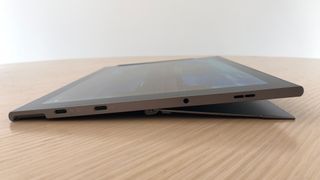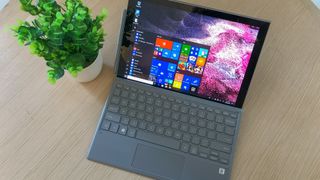Why you can trust TechRadar
Now, here comes the not-so-fun part. The rumors, sadly, were true: Qualcomm’s Snapdragon 850 isn’t the leap in power over the Snapdragon 835 that was sorely needed here. Our benchmark results may show a massive increase, but that doesn’t translate as well to real-world use much less keep up with Intel and AMD’s latest advances in mobile processing.
Also, and while this varies vastly on factors like screen resolution and brightness, we’ve seen largely the same battery life figures as before. All told, we were expecting a bit more than this with the Snapdragon 850 chipset being expressly designed for Windows 10, whereas the 835 was simply a phone or tablet chip repurposed for Microsoft’s operating system.
Here’s how the Samsung Galaxy Book 2 performed in our suite of benchmark tests:
Geekbench 4 Single-Core: 2,337; Multi-Core: 7,469
Battery Life (TechRadar movie test): 10 hours and 41 minutes
While we only have one major performance test to go off of, our real-world time with the tablet doesn’t exactly do the Galaxy Book 2 any favors, either. The 4GB of memory on offer, simply put, isn’t enough to keep up with modern multitasking.
You’re going to tear through that memory easily with more than a few web browser tabs open at once. Couple that with a streaming music player in the background and maybe a chat app, and you’ll have tapped that memory as well as sent the ARM-based processor into a tizzy. If Samsung included a little more memory to be comparable with rivals, this might be a different discussion – but only slightly so.
For a similar price, the Intel processor within the Surface Pro 6 absolutely runs circles around the Snapdragon chip inside the Galaxy Book 2. Better yet, it’s not that far off in terms of battery life, which is frequently touted as the key feature of Snapdragon processors.
We haven’t even gotten into emulation yet, or running non-Windows Store apps within a virtualized desktop environment that otherwise wouldn’t support those programs, which is required for a decent amount of popular Windows 10 software, like Google Chrome and many cloud-connected storage drive apps (that aren’t Microsoft OneDrive).
Emulating apps creates an inherent overhead in available performance throughput, as some of that immediately gets dedicated to running that emulated environment in which these otherwise incompatible apps can function. That’s not good when you’re already at a performance disadvantage. So, this ultimately limits the Galaxy Book 2’s use cases to some very basic ones (such as email and streaming media) that, frankly, could be served equally as well for less cash.

Battery life
While we were able to run only one test on the Galaxy Book 2 when it comes to battery life, it’s not exactly promising considering both the promises of Samsung regarding its tablet and Qualcomm regarding its new processor. Samsung says that the Galaxy Book 2 can last up to 20 hours on a charge, while Qualcomm promises a 20% increase in battery life over its previous Windows 10 processor.
In our rather basic local video playback test, the Galaxy Book 2 didn’t come close to either claim.
In fact, the 10 hours and 41 minutes that the tablet lasted is 10 minutes short of the widely-panned Asus NovaGo; though, the tablet’s far sharper screen may be mostly to blame here. Either way, this is neither the increase in longevity we were hoping for nor does it come close to Samsung’s claims, but still nevertheless lengthy compared to most Windows tablets.

Software and features
Aside from the fingerprint sensor and ace stylus support, there isn’t much more to speak of regarding software and features unique to the device. Like the Surface Pro 6, if its on Windows 10, then every other tablet has the same features and software.
In fact, the presence of an ARM-based processor actually might keep you from some features or apps you’ve grown accustomed to on other Windows 10 laptops or tablets.
However, there is Samsung Flow, which allows connectivity and management of nearby Samsung phones and tablets running Android. Though, this is basically a moot point with the new Your Phone app from Microsoft. The same goes for the included Samsung Notes and Gallery apps: Microsoft’s OneNote and and Photos app simply manage those tasks better and more robustly.

Final verdict
There are a lot of things going for the Samsung Galaxy Book 2, namely a fantastic new design that brings it more in line with the norm for the product category, some impressive battery life and accessories included in the box. However, this is yet another Windows tablet that’s largely held back by its processor platform of choice – not to mention supporting hardware.
Simply put, this processor isn’t powerful enough to support a power user’s – the very people that would spend a thousand on a hybrid tablet – workload, much less with the paltry memory and storage on offer. Worse off is that users are bound to run into situations wherein the app they wish to use isn’t supported or must be emulated to do so.
Emulation, which requires additional processing power to create a virtual environment in which an unsupported app can function, is not a solution when a device doesn’t have the performance bandwidth to spare in the first place. What’s especially disappointing is that this would potentially be a different review entirely if not for the processor choice.
Unless you’re dead set on Samsung’s line of Windows tablets, there are plenty of options out there that are more powerful, versatile and not that far behind in terms of battery life.
- 1
- 2
Current page: Performance, battery life, features and verdict
Prev Page Introduction, price, design and displayJoe Osborne is the Senior Technology Editor at Insider Inc. His role is to leads the technology coverage team for the Business Insider Shopping team, facilitating expert reviews, comprehensive buying guides, snap deals news and more. Previously, Joe was TechRadar's US computing editor, leading reviews of everything from gaming PCs to internal components and accessories. In his spare time, Joe is a renowned Dungeons and Dragons dungeon master – and arguably the nicest man in tech.

A key Apple app is rumored to be getting a major upgrade in macOS 15

Intel's formidable 288 core CPU now has a proper family name — Granite Rapids and Sierra Forest are Xeon 6 processors but is it just becoming too confusing?

Get six months of Disney+, Hulu, and ESPN+ free at Verizon with this epic deal

